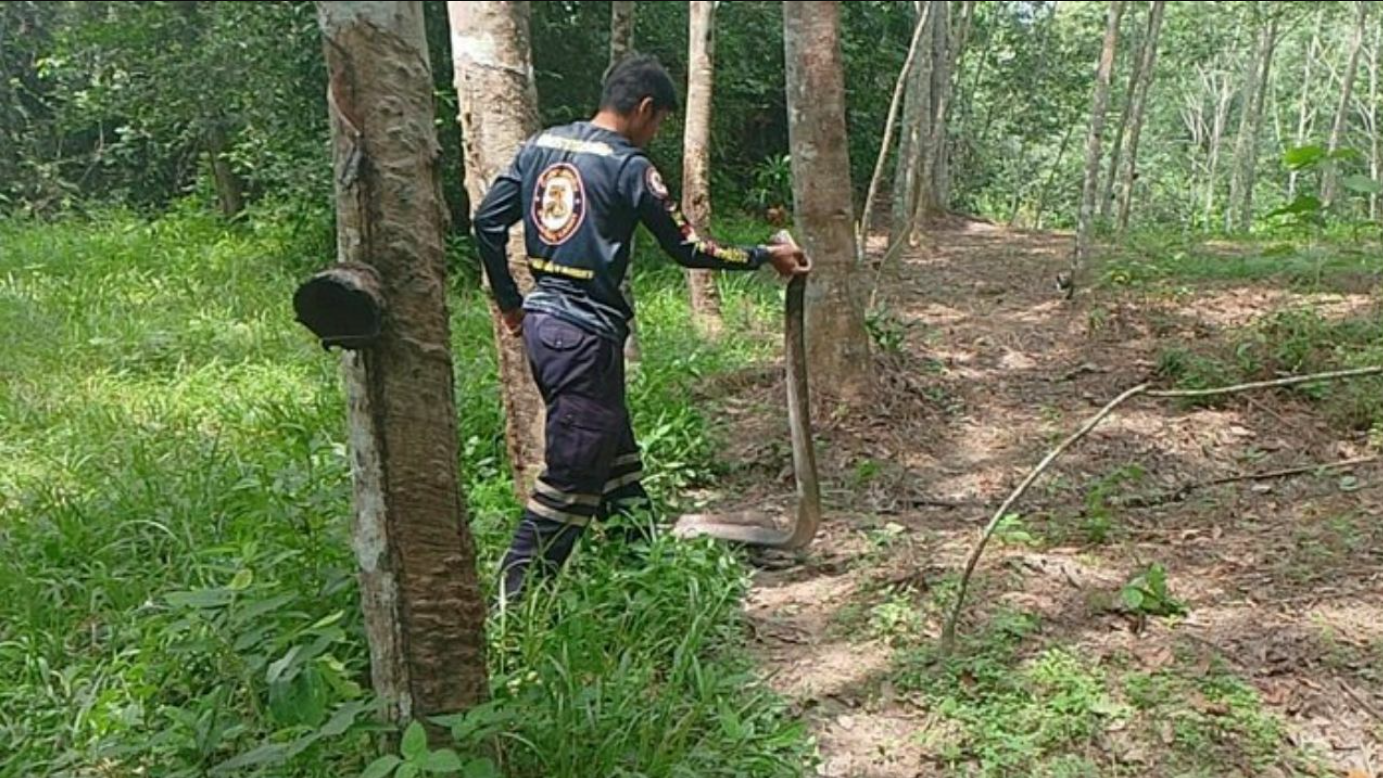Imagine strolling through a lush plantation in Thailand—banana palms swaying, heat hanging in the air—and suddenly witnessing nature’s raw drama unfold. A king cobra, the world’s longest venomous snake, lunges at and devours another snake. Eye-popping? Absolutely. Spine-tingling? You bet. It’s not everyday workers see such a chilling spectacle during their morning rounds.
What Happened in the Thai Plantation?
Plantation workers in southern Thailand were in for quite the surprise. As they started their day, a large king cobra appeared—slithering silently through the greenery. Several nearby snakes, tempted by warmth and prey, encroached on its territory. Without warning, the cobra struck, capturing one of the smaller snakes in its jaws.
The crowd watched in stunned silence as the cobra coiled around its victim, crushing it, then slowly swallowed it head-first—a gruesome yet mesmerizing display of nature’s balance.
Understanding King Cobra Behavior
King cobras (Ophiophagus hannah) are apex serpents. Their diet primarily consists of other snakes—including venomous ones—alongside monitor lizards and even small mammals. They hunt with lightning speed, delivering neurotoxic venom that paralyzes prey almost immediately.
-
Territorial dominance: King cobras often patrol large areas, defending against intruders, including other snakes.
-
Ambush experts: These serpents rely on camouflage and patience, waiting for the perfect moment to strike.
-
Not mindless killers: Their strikes are strategic, aimed at quickly neutralizing threats and reducing energy expenditure.
Why Did This Encounter Alarm the Workers?
Workers in Thai plantations aren’t strangers to snakes—but witnessing a king cobra in action is a whole different story.
-
Unexpected appearance: These events are rare and chaotic, especially in early shifts when awareness is low.
-
Venomous danger: One bite from a king cobra can wreak havoc on the nervous system, making any encounter potentially lethal.
-
Visual trauma: Seeing a snake consume another snake is, let’s face it, unsettling—like a wildlife documentary unfolding live and unedited.
Safety Tips for Plantation Workers (And You Too!)
Stalked by a serpent? Here’s what you can do to stay safe:
-
Keep your eyes peeled: Watch where you step or place tools—especially in dense foliage.
-
Stick with buddies: There’s strength (and safety) in numbers; snakes are less likely to approach groups.
-
Maintain clear spaces: Cut back overgrown plants around walking paths to reduce snake habitats.
-
Wear protective gear: Think thick boots and snake gaiters if you live or work in a snake-prone zone.
-
Know emergency protocols: Have anti-venom information and the nearest medical facility’s contact details handy.
Comparing King Cobra with Other Cobra Species
| Feature | King Cobra | Indian Cobra | Monocled Cobra |
|---|---|---|---|
| Scientific Name | Ophiophagus hannah | Naja naja | Naja kaouthia |
| Average Length | 3–4.5 meters | 1–1.5 meters | 1–1.75 meters |
| Primary Diet | Snakes, lizards | Rodents, frogs, birds | Rodents, snakes, small mammals |
| Venom Type | Neurotoxic | Neurotoxic + Cytotoxic | Neurotoxic + Cardiotoxic |
| Habitat | Forests, plantations | Grasslands, agricultural fields | Wetlands, rice paddies |
| Behavioral Notes | Highly territorial, arboreal | Aggressive when provoked | Nocturnal, more shy around humans |
The Ecological Importance of King Cobras
Don’t judge a snake by its bite. Despite their fearsome reputation, king cobras play a crucial role:
-
Population control: By feeding on pest species, they help maintain ecosystem balance.
-
Indicators of environmental health: Their presence suggests a thriving ecosystem rich in biodiversity.
-
Eco-tourism attraction: With proper safety measures, sightings can attract nature lovers and photographers.
What Can Authorities and Farmers Do?
To reduce conflicts and keep both people and snakes safe, consider these strategies:
-
Community awareness campaigns: Teach locals to identify and peacefully avoid king cobras.
-
Habitat preservation: Design plantation boundaries that offer snakes natural cover away from people.
-
Warning systems: Use snake-repelling plants or low-frequency sensors for early snake detection.
-
Medical readiness: Stock anti-venom and train staff in snakebite first-aid.
Myths vs. Facts about King Cobras
Let’s burst some bubbles:
-
Myth: King cobras chase humans.
Fact: They avoid humans whenever possible and rarely bite unless threatened. -
Myth: Antivenom isn’t effective.
Fact: Modern antivenoms exist and are quite effective—if administered quickly and correctly under medical supervision. -
Myth: All cobras are aggressive.
Fact: Each species varies. The king cobra uses venom sparingly and primarily for prey, not projectiles or defense like some other snakes.
Conclusion
Nature sometimes shows its raw, slow-burning power—like a king cobra devouring another snake. For plantation workers in Thailand, it was a vivid reminder to stay alert, respect wildlife, and follow safety guidelines. By understanding these majestic yet deadly serpents, we can coexist—preserving both human life and the balance of nature.
